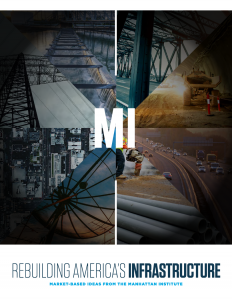 This is the new administration’s “infrastructure week” in which they are rolling out new proposals such as privatizing air traffic control.
This is the new administration’s “infrastructure week” in which they are rolling out new proposals such as privatizing air traffic control.
To dovetail with this, the Manhattan Institute has just published a new booklet called “Rebuilding America’s Infrastructure” that includes some of our best thinking on the topic.
This includes much of my own MI work, including my recent American Affairs article, and studies on sewer upgrades, driverless cars, and local street repairs.
It also features work from Harvard economist and MI Senior Fellow Ed Glaeser, who writes about the limits of privatization and why so much transportation spending goes to bad projects.
And my colleague Nicole Gelinas talks about the need to reform our infrastructure spending system before pouring more money into it, and specific ways to rebuild America’s infrastructure at lower cost, and more.
There are several other chapters as well. Here’s are some excerpts from Glaeser:
The Impossible: Private maintenance of existing infrastructure. For decades, transportation economists have emphasized that the highest returns come from investing in existing infrastructure. In some cases, this means repairing potholes and ensuring the structural integrity of a bridge. In other cases, this means imposing smarter tolls that vary by time of day to ensure more efficient usage. In theory, privatizing some roads, bridges, and tunnels will solve these problems. A private provider will have incentives to ensure that the road doesn’t become unusable. A private toll company will be happy to impose time-varying tolls to make a road more attractive and profitable. Yet throughout much of America, privatization is politically unlikely and tolling is deeply unpopular. Like government, private providers may skimp on safety, especially when the benefits from spending on maintenance are not always immediately obvious to drivers.
The relatively simple technology of infrastructure construction of the 1930s meant that the unskilled unemployed could easily be put to work building roads. Among the iconic images of the Great Depression are scores of men wielding shovels and picks. That isn’t how roads and bridges are built anymore, though. Big infrastructure requires fancy equipment and skilled engineers, who aren’t likely to be unemployed. The most at-risk Americans, if they’re working at all, usually toil in fast-food restaurants, where the average worker makes $22,000 a year. They’re typically not trained to labor on complex civil-construction projects. Subsidizing Big Mac consumption would be a more effective way to provide jobs for the temporarily unemployed than subsidizing airport renovation.
Some excerpts from Nicole Gelinas:
From Silicon Valley to Massachusetts, highways are getting more crowded at rush hour, yet almost nobody takes the train to work. As rookie New Hampshire Sen. Maggie Hassan said at Chao’s hearing, even her once-rural state could use commuter-rail investments into Boston as the immediate suburbs become more crowded and expensive. Let’s have a national contest for new commuter-rail line cash for regions willing to build denser housing — condos, apartments and single houses closer together — around those lines. More commuter rail would take some pressure off high-cost cities, too, as people would have more housing options outside of the metropolises.
Poorer areas are in a vicious circle: If you can’t deliver water, keep the streetlights on and fill in potholes, you’ll lose even more residents. The feds should offer grants and zero-interest loans for particularly distressed areas, coupled with outside management expertise to help them relearn the basics. For middle-class and wealthier areas, the feds could offer smaller grants and slightly higher interest-rate loans to do the basic work of filling in the cracks in the roads. Some of these boring but vital projects are expensive, too: New York will need close to $2 billion to keep the Brooklyn-Queens Expressway from falling down.
Don’t be afraid to think small. Small federal grants—in the millions or tens of millions of dollars each—can help states, cities and towns start or improve bus service, build sidewalks and bike lanes, and otherwise give people more choices on how to get around in addition to the automobile. Such investments are good for poorer people, who must spend more of their money, as a percentage of income, on transportation.
Click through to read the whole thing.
Cover image via Chicago Transit Authority, CC BY-NC-ND 2.0
from Aaron M. Renn
http://www.urbanophile.com/2017/06/08/how-to-rebuild-americas-infrastructure/
No comments:
Post a Comment